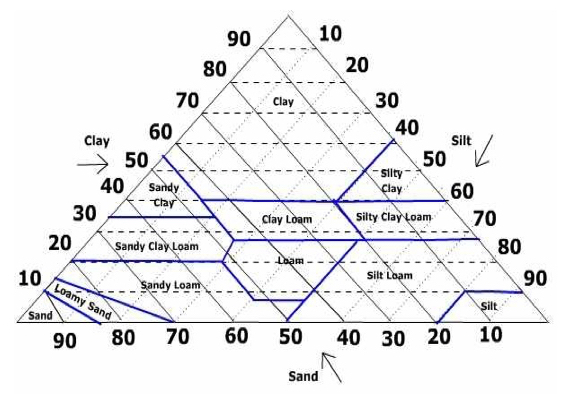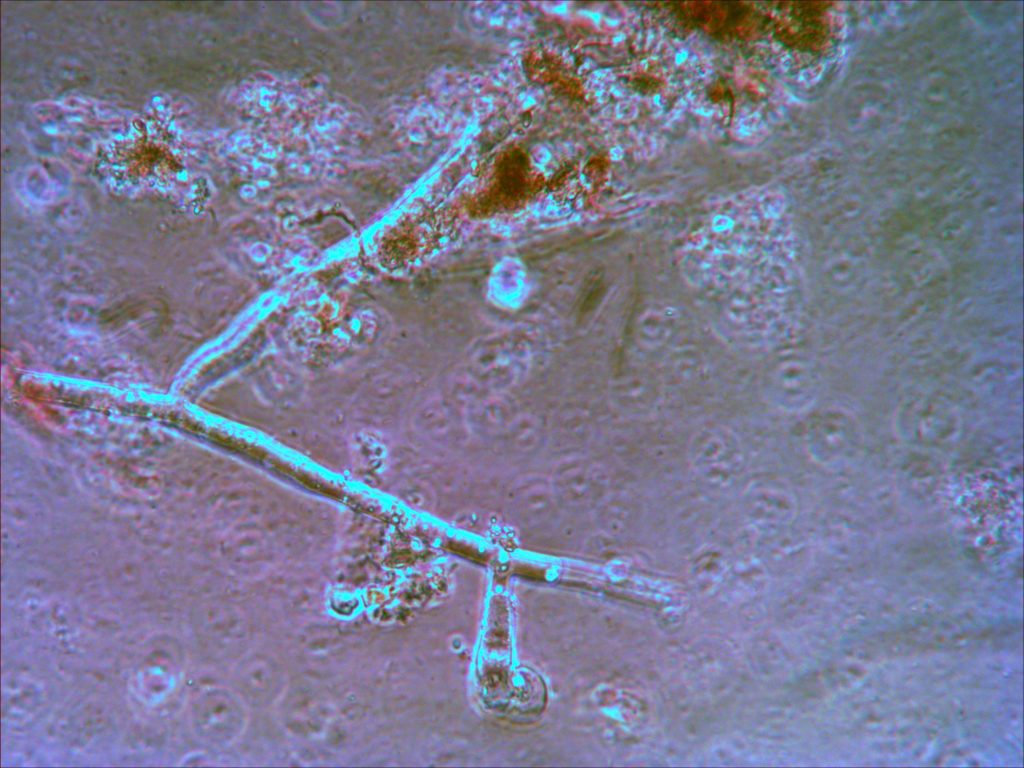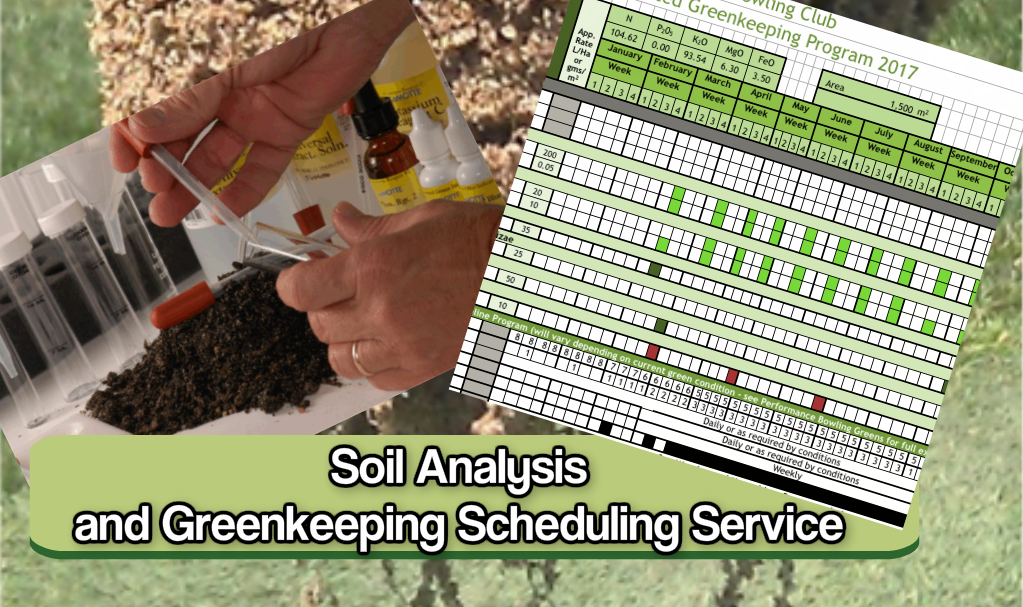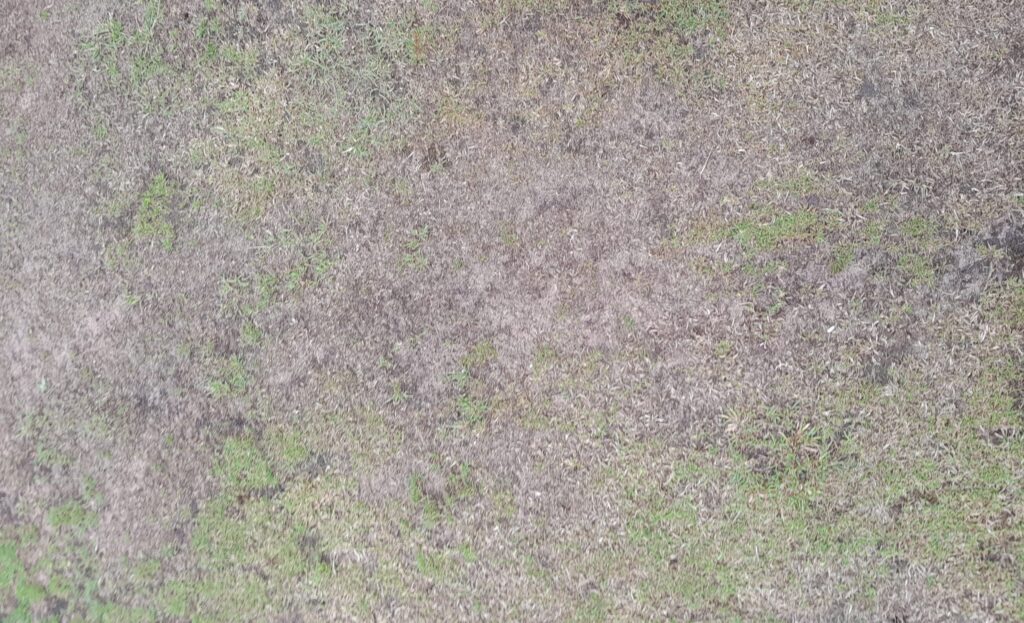Yes, I’m thinking about Autumn already. Why?, It’s all to do with the devastating effect of Localised Dry Patch on many greens this year. I’ve ever had so many people get in touch. It looks like the more regular occurrence of extreme heat and long dry spells is demonstrating the problem of excessively sandy rootzones, much better than I could ever hope to explain…
The circle of decline describes a situation that many greens gradually slip into after years if not decades of conventional greenkeeping. Breaking into the Circle of Decline is an urgent requirement for many UK bowling clubs, hence this early warning to start thinking about your autumn renovation programme now, hopefully before you’ve ordered the top-dressing! . Let me explain…
Conventional greenkeeping?
I use this term to describe a form of greenkeeping that has increasingly become the accepted norm since the end of World War 2, driven largely by two factors; the agro-chemical industry need to sell increasing amounts of stuff and the advances in turf management driven by an upsurge in golf course construction in the USA and Europe.
Now, for bowling clubs especially, this greenkeeping model is letting clubs down in terms of green condition, health and ultimately performance. It sets out to exert control over the green and to dictate its performance, an approach that probably worked for a little while back in the early days. In fact it still works in some golf situations, but even that is being called into question now, as it requires continual inputs at a time when pesticides are becoming less available and greenkeeping is as a becoming ever more expensive and complex.
Symptoms
It can be defined as symptoms management, or in other words waiting for something to go wrong and then treating it with some potion or other.
The defining features of this approach are:
- continued use of sand top-dressing as a feature of the annual renovation program.
- routine use of preventative fungicides to control turf disease
- routine use of inorganic, mineral fertilisers to provide growth in otherwise inert soil conditions
The problems caused by 2, 3 or more decades of this kind of maintenance can be observed on a high proportion of the bowling greens in the UK. Depending on the stage of development of the Circle of Decline, some or all of the following problems will be observed:
- Inert soil, layers and root-break caused by the overuse of sand top-dressings
- Thatch build up on the surface due to the lack of microbial activity in very sandy soils, leading to bumpy, slow, uneven and unpredictable playing characteristics.
- Hydrophobic soil and localised dry patch leading to soil and turf that repels moisture
- Shallow rooted Annual Meadow Grass (Poa annua) domination of the sward causing problems with surface performance, due to seed-head production, clumpy growth and skinning of heads due to shallow rooting.
- Thatch collapse due to drying out of excess thatch
- Frequent fungal disease outbreaks in autumn and increasingly in summer too
- Moss infestation encouraged by thinning turf
- Chemical imbalances in the soil due to excessive sand and thatch build up including pH, CEC and Base Saturation problems.
- High levels of residual iron due to over reliance on sulphate of iron moss-killers and fertilisers and poorly aerated soils
- High mineral salt levels due to use of inorganic fertilisers leading to reduced nutrient and moisture uptake.
Phew!, I could go on, but I think it will be clear by now that this is a big problem for clubs. Continuing on this path is suicidal financially for most bowling clubs and a different approach is required by many.
You’ll notice I didn’t say a New approach, because what I promote in my Performance Bowling Greens Program is really quite old fashioned and harks back to the days when greenkeepers worked hand in hand with nature and had no access to pesticides or mineral fertilisers to any great degree.
It’s also worth reminding ourselves at this point that the grasses that make the finest bowling surfaces managed to thrive and survive with no human input for millions of years before anyone ever bowled or putted!
Greenkeepers then, can reap huge benefits by getting back to nature. Don’t worry, you don’t have to take your clothes off or anything weird, unless you want to of course; but you do need to commit to getting more involved with your turf and soil. To keep it topical with recent newsletters, you need to employ a more confident and bold approach to greenkeeping. If I had to distill this into one action any greenkeeper can take it would be to dig more holes and look at what’s under your feet!
Breaking Into the Circle of Decline
I’m asked a lot about the best time and the best place to halt the progress of the Circle of Decline and the annoying answer is that there is no ideal time or place; just start!
However, it’s likely that you will encounter a bit of friction in your club if you start to talk about all of this airy fairy nature stuff all of a sudden. In fact you might as well take your clothes off at this point if you introduce it in an all or nothing, shouty way.

A Gentle Start
It’s usual for a greenkeeper to read, learn and start to see the sense in the approach I promote in Performance Bowling Greens, which is good, BUT, then comes the hard bit, convincing others!
That’s why I advise converts to find a place to start that will give them some early wins and evidence to support their ideas.
2023 has been a great year for doing this as many greens have suffered devastating Localised Dry Patch (LDP) and that is as a good place as any to start breaking into the Circle of Decline.

LDP has been a problem for a long time now. It’s an issue that crops up usually, when greens have too much sand in the rootzone. I’ve been dealing with it for a long time. It is usually accompanied by annual meadowgrass (Poa annua), dense or at least excessive thatch build up and in winter there is usually a lot of dark coloured moss in these areas.
Greens should ideally be very sandy, but many bowls and golf clubs sometimes take the view that if a little is good, then a lot must be better. You see this a lot where clubs will put on twice the dose of fertiliser or pesticide or double the recommended seeding rate, thinking it’s good. It’s actually more like over-dosing on your prescription medicine. Many clubs have now been overdosing on sand for a very long time.
The “very sandiness” required is quantifiable to some degree and we use a graphic called the Soil Texture Triangle to illustrate this.

Ideally, your rootzone (top-soil) would fall into the Sandy Loam sector of this triangle, but many greens are already in the Loamy Sand and in a lot of cases Sand sectors. This means they have too much sand in the rootzone.
That said, greens in the Sandy Loam sector can still get LDP, but it’s less likely. The soil texture triangle is explained in this article
This can be quantified for your soil using the Particle Size Distribution (PSD) test detailed on this page.
This will give you a picture of the Physical condition of your soil. The Physics of your soil is very important in terms of drainage, water availability for plants and nutrient availability.
Incidentally, I described a method for dealing with Localised Dry Patch which cuts to the root of the problem here.
The Difference
The difference between this approach and the conventional one is that it recognises that we are dealing with a living eco-system. In a teaspoon of healthy soil there are a billion soil microbes (bacteria, fungi, nematodes, protozoa etc) all of which have a role to play in the health of the system. Plants, organisms and micro-organisms interact with each other and form symbiotic relationships to survive and thrive. They each have a niche (a set of circumstances) that they occupy in this eco-system. We simply need to provide a set of conditions (a niche) that favours Agrostis (bentgrass) and Festuca (fescue) grasses. These are perennial grasses.

Perennial grasses form important symbiotic relationships with soil fungi called mycorrhizae, but conventional greenkeeping sees fungi as a the bogeyman (some fungi, such as fusarium are pathogenic to some grasses in some conditions, usually in anaerobic conditions due to dense thatch) and uses broad spectrum (wide ranging control) fungicides to kill and prevent outbreaks of fungal disease. I could go on with this for a very long time, but to cut a potentially very long story short, this is the crux of the phenomenon I’ve termed the Circle of Decline. One thing leads to another. Very sandy soil is low in microbes and in some cases inert. More detailed explanation here

Physics, Chemistry and Biology
So to some extent, that is the Physics and the Biology of your green in a nutshell.
Which leaves only the Chemistry to discuss. All of this usually comes along with other, underlying soil chemical problems due to there being excessive amounts of sand. Sand is inert, doesn’t hold much moisture or nutrition and as we’ve seen, much in the way of microbial life which is very important for plant health. This has led to a heavy reliance on mineral (non organic) fertilisers which are naturally very high in mineral salts.
Typical chemical problems I see in soil samples from bowling clubs every week are low pH, low Cation Exchange Capacity (CEC), high levels of mineral salt which can cause water uptake problems and Base Saturation anomalies which make it difficult for grass plants to take up enough nutrition. These terms are explained here.
Conventional Greenkeeping attempts to deal with the influences of soil Physics, Chemistry or Biology in isolation. For example in soil Physics, sand is so popular as when it is used correctly, it can improve the drainage of the soil. It does this by altering the soil’s texture on the soil texture triangle, but as we’ve seen this can be taken too far to the stage where it is doing damage.
Unfortunately, this overuse of sand has a knock on effect on soil biology and chemistry. On the chemical front, the Cation Exchange Capacity of very sandy soils is very low. Biologically, overuse of sand causes reduced Organic matter which negatively affects the populations of beneficial aerobic microbes. Dense thatch, which is a typical side effect of inert soil can become anaerobic, tipping the green eco-system in favour of pathogenic microbes like fusarium disease.
So we need to deal with the three big sciences as a whole; one influences each of the others…this, as far as greenkeeping is concerned needs an approach that understands and takes account of the overall ecology of the green and its surroundings.
Saving Money
I’ve left the question of money until last, as it should come as a pleasant surprise. Changing your greenkeeping approach, to a more natural, ecologically focussed program will inevitably cost less. Of course there will be a renovation phase, where built up problems will have to be dealt with in order to get things moving quickly, but this should be relatively short lived.
It’s impossible to put a figure on the potential savings that will fit every club’s circumstances, but let me give you a simple factual example here to illustrate the potential:
When I develop a maintenance program for a bowling green at the start of the recovery process I typically aim to provide for applying the equivalent of 100kgs/Ha of Nitrogen per year in the fertiliser program. This level of input is needed in order to support growth in this early phase. However, a healthy, natural soil system supporting the fine perennial grasses (bent/fescue) with a fully functioning soil microbial population will easily produce up to 50kgs/Ha of Nitrogen per year, just by the action of soil microbes degrading the dead material destined to become thatch in a less healthy green.
From this you can see that the potential reductions in fertiliser use alone could amount to a substantial saving, while still making huge improvements to the green’s performance. When you add in reduced costs for sand and pesticides this can grow into very attractive savings for clubs.
You might surmise that the reduction in inputs, would be balanced out by an increase in physical work required, but over time this can also be reduced as the green becomes more self sustaining with minimal inputs.
It might sound too good to be true at this stage, but if it helps, you can have it all laid out on paper, specifically for your club by taking advantage of my Greenkeeping Advisory Service detailed below.
Getting to Grips with Your Soil Condition
The grass plants you are trying to grow and nurture are reliant on the soil for their success, so there is no better preparation for starting your new, performance focussed approach to greenkeeping than to build a deeper understanding of your soil.
Soil Analysis
Chemical and Textural Analysis
This service provides you with the following:
A Comprehensive Chemical Analysis and Soil Texture Assessment of your green’s soil (rootzone). You will receive soil sample bags with instructions for taking and returning (freepost) your soil samples to the lab.
I will personally interpret and report back to you on the lab results with a full report detailing all Primary, Secondary and Trace elements, Cation Exchange Capacity, Base Saturation, Electrical Conductivity, Organic Matter, pH and your soil’s position on the Soil Texture Triangle (assessed by the Laser Diffraction method).
In addition to my comprehensive report, I will provide you with a suggested greenkeeping plan for making the required improvements to your green, based on the soil analysis results and any other information you are able to provide.
After you order your soil analysis, I will contact you to provide instructions for taking your soil samples and to guide you on collecting further evidence from your green to help with my appraisal and advice.
Afterwards, you can contact me any time for help.



